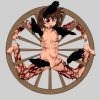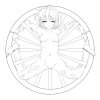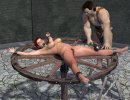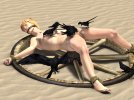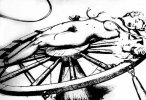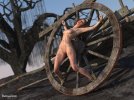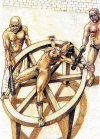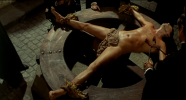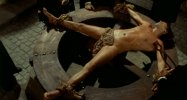-
Sign up or login, and you'll have full access to opportunities of forum.
You are using an out of date browser. It may not display this or other websites correctly.
You should upgrade or use an alternative browser.
You should upgrade or use an alternative browser.
Broken On The Wheel
- Thread starter cruxpain72
- Start date

gjpain
Governor
foggybottom
Venator imaginum
That looks like Interrogatio "Wheel of Pain". They also made another wheel film "Die Rosen Hexe" the "Rose Witch".Which movie is this?
Same scene with better resolution:my torment with the Borgia
My divine torture.
View attachment 872827View attachment 872828View attachment 872832View attachment 872833View attachment 872834View attachment 872835View attachment 872836
Vindex
Tribune
Sorry, but I did not know that I had just made a post similar to yours.Same scene with better resolution:
Don't worry!Sorry, but I did not know that I had just made a post similar to yours.
I searching always, before I start a new thread, for similar or same topics.
aleva
Condemned
I looked for the story. Where I can read the text of Merril?Some wheel pics I found in my 2008 archive
View attachment 872488View attachment 872489View attachment 872490View attachment 872491
jucundus
Diva
Inspired by @Eulalia's beautiful poem, I came up with this image of a girl chained to the wheel. The picture does not actually describe the scene in the poem; I was caught by the way the poem left everything to the reader's imagination and ends BEFORE the actual torture starts. This final emotion of fearful submission to incredible pain is what I wanted to reproduce. (Also, I tried to live up to @Barbaria1's kind words and spent more time on the facial expression than on the correct positioning of the labia...  ).
).

 ).
).
(Also, I tried to live up to @Barbaria1's kind words and spent more time on the facial expression than on the correct positioning of the labia...).
And you succeeded admirably! Nice!

I think you have effectively captured the anticipation in the poem and that sense of being on the edge of an event - the moment of moving from one state to another, anticipation, fear, etc. It's all there, with the just visible, muscular body of the executioner holding the second wheel giving it an immediacy and sense of inevitability. The girl's expression is very well rendered as well - a bit of resignation, but still trying to take it bravely. Really well done.Inspired by @Eulalia's beautiful poem, I came up with this image of a girl chained to the wheel. The picture does not actually describe the scene in the poem; I was caught by the way the poem left everything to the reader's imagination and ends BEFORE the actual torture starts. This final emotion of fearful submission to incredible pain is what I wanted to reproduce. (Also, I tried to live up to @Barbaria1's kind words and spent more time on the facial expression than on the correct positioning of the labia...).
View attachment 908168
That's great, thankyou so much Jucundus - you've captured the sense of awful anxiety and ebbing confidence in the young martyr as the awful reality comes close ... I'm honoured that my writing has inspired such a fine image.Inspired by @Eulalia's beautiful poem, I came up with this image of a girl chained to the wheel. The picture does not actually describe the scene in the poem; I was caught by the way the poem left everything to the reader's imagination and ends BEFORE the actual torture starts. This final emotion of fearful submission to incredible pain is what I wanted to reproduce. (Also, I tried to live up to @Barbaria1's kind words and spent more time on the facial expression than on the correct positioning of the labia...).
View attachment 908168
specimeat
Assistant executioner
This followed by impalement: my 2nd-preferred execution method after crucifixion!!!Some wheel pics I found in my 2008 archive
View attachment 872488View attachment 872489View attachment 872490View attachment 872491
specimeat
Assistant executioner
(PS. Actually, i guess i "feel" it as an extreme variant of crucifixion of sorts...)This followed by impalement: my 2nd-preferred execution method after crucifixion!!!Some wheel pics I found in my 2008 archive
View attachment 872488View attachment 872489View attachment 872490View attachment 872491
paolo andrei
Magistrate
an amazing old work depicting the long and excruciating Merryll's agony, they show perfectly the horrors of the weelSome wheel pics I found in my 2008 archive
View attachment 872488View attachment 872489View attachment 872490View attachment 872491
Last edited:
lember
Magistrate
I found a contemporary source. The senseless and professional process of execution of law, and the priest they provided as consolation makes it awkward and scary
Being Broken on the Wheel in the 18th Century
By Geri Walton | July 15, 2016 | 0
In France, in the 1700s, when people were condemned to death, those convicted of certain atrocities were sometimes condemned to be broken on the wheel in a public execution. Sometimes after being broken on the wheel, blows were also given on the chest or the abdomen of the condemned person. These blows were called coups de grâce, or in other words, “blows of mercy,” as they were fatal to the condemned. If these blows were not given, a condemned person might live for hours or days, and they might be subject to birds pecking at them until they died. In addition, on occasion, a special grace, known as the retentum, was granted where a condemned person was strangled after the second or third blow, or in special cases, even before the breaking began.
Public square in 4th Arrondissement of Paris, now called Place de l’Hôtel de Ville (City Hall Plaza) was, before 1802, called Place de Grève. Courtesy of Wikipedia.
This practice of being broken on the wheel was reported on by an Irish gentleman visiting Paris, France, in 1788, a year before the French Revolution broke out and five years before Louis XVI and Marie Antoinette would be executed by the guillotine. He wrote a letter to a friend in Ireland dated July 23rd, and, in the letter, he described the torturous punishment that one Parisian criminal experienced on the wheel. Here is his letter verbatim:
Being Broken on the Wheel in the 18th Century
By Geri Walton | July 15, 2016 | 0
In France, in the 1700s, when people were condemned to death, those convicted of certain atrocities were sometimes condemned to be broken on the wheel in a public execution. Sometimes after being broken on the wheel, blows were also given on the chest or the abdomen of the condemned person. These blows were called coups de grâce, or in other words, “blows of mercy,” as they were fatal to the condemned. If these blows were not given, a condemned person might live for hours or days, and they might be subject to birds pecking at them until they died. In addition, on occasion, a special grace, known as the retentum, was granted where a condemned person was strangled after the second or third blow, or in special cases, even before the breaking began.
Public square in 4th Arrondissement of Paris, now called Place de l’Hôtel de Ville (City Hall Plaza) was, before 1802, called Place de Grève. Courtesy of Wikipedia.
This practice of being broken on the wheel was reported on by an Irish gentleman visiting Paris, France, in 1788, a year before the French Revolution broke out and five years before Louis XVI and Marie Antoinette would be executed by the guillotine. He wrote a letter to a friend in Ireland dated July 23rd, and, in the letter, he described the torturous punishment that one Parisian criminal experienced on the wheel. Here is his letter verbatim:
This execution was one of the last being broken on the wheel in France. A few weeks later, on 3 August 1788, the execution of Jean Louschart was scheduled in Versailles using a wheel. Louschart had been convicted of murdering his father, Mathurin. However, many people supported Louschart, thought him not guilty, and showed that Louschart “had been the patient victim of the whims and acrimonious temper of old Mathurin.”[2] On the day of the execution, a sympathetic crowd decided to storm the scaffold, and they rescued Jean Louschart. There were also many other critics who believed the wheel was too torturous a form of punishment, which also helped to put an end to the French using the wheel.“I have been to see a most dreadful spectacle, a man broke alive upon a cross: which they call breaking on the wheel. At about four of the clock in the evening I went to the place de greve where public executions and rejoicings for the birth, &c. of any of the royal family are continue to be performed. There was a very great multitude of people assembled together, and in the midst of the place was erected a wooden stage. I got up into a high window, from which I had a commanding prospect of this frightful business.
On the scaffold was laid horizontally a large wooden cross, much in the form of a Roman X. This cross was marked with eight square notches, two on each extremity, and about five inches in depth. On this cross, I was informed, the condemned prisoner was to have his limbs broken and be put to death. At one end of the scaffold a small coach wheel was horizontally placed upon a perpendicular axle-tree or post. On this wheel, I was told, the body of the prisoner was to be left exposed, after having been broken on the cross.
In a short time the unhappy prisoner arrived, in company with the executioners, and conducted by a party of the horse guards of the police, or guet-à-cheval. The prisoner with the executioners went into the town-house, where they remained for about half an hour. The prisoners are conducted to the town-house to be examined for the last time; and there I suppose this prisoner was put to the torture; for on coming out, he was unable to walk, and was borne up by the two troopers.
Arriving at the scaffold, three executioners dressed in a genteel and fashionable stile, handed the prisoner up the ladder with seeming politeness and civility. Having ascended the scaffold, he knelt down and prayed for some time with a clergyman in a black cassock, whose conduct on the whole appeared decent, pious and proper. After praying for some minutes, the prisoner suffered the executioners to take off his clothes. He then layed himself on his back upon the cross, and stretched out his legs and arms along its extremities; while an executioner fastened down his limbs with straps and buckles.
Here I turned my eyes from this frightful spectacle, and beheld the whole place covered with a multitude of people, with their faces all turned to the scaffold: and strange as it may appear, the greater number were women. It is amazing, how the more delicate part of the creation, whose feelings are so exquisitely tender and refined, should come in crouds to see so bloody a spectacle: Yet without doubt, it is the pity, the kind compassion which they feel, that makes them so anxious about the tortures inflicted on our fellow creatures.
The noise of the multitude was like the hoarse murmur caused by the waves of the sea breaking along a rocky shore: For a moment it subsided; and in an awful silence, the multitude beheld the executioner take up an iron bar, and begin the tragedy, by striking his victim on the fore arm, which being placed immediately over one of the notches, was by the blow of the bar, smashed and crushed down into it. He next struck one of the legs in the like manner, and crushed the bones and flesh at one blow into the notch. He then broke the fore arm in the same manner; then a thigh next an arm, after that the other thigh, and concluded by breaking the remaining arm. The priest who still continued with the dying man, knelt down, praying with him, and giving him such consolation, as in such cases can only be drawn from conscious innocence, or a lively hope of Divine mercy, and being shortly translated to a happier existence.
A halter had been fixed round the neck of the prisoner, the end of which the executioner pushed through a small hole in the scaffold, which he immediately corresponded to the back part of the prisoner’s neck when extended on the cross. All the limbs of the prisoner being broken, the execution looked at his watch and let the prisoner remain in that deplorable situation for some minutes according to his sentence. The time being elapsed, an executioner under the scaffold fastened the extremity of the halter to a windlass. He then waited for about a minute, when on a signal given by the principal executioner, he began to turn the windlass, and gave the ropes some violent tugs, such as must have dislocated the vertebrae of the prisoner’s neck. During this transaction the other execution on the scaffold again took up the iron bar and gave the prisoner three most violent blows upon the belly and stomach, such as must have burst the heart, arteries, stomach, diaphragm, and intestines, and confounded them into one mass of blood and wounds.
After some time, the priest descended from the scaffold. The prisoner being sentenced to remain upon the cross until he was absolutely dead, the executioner still remained upon the scaffold, frequently extending the fingers of the prisoner, to know if they would contract, and shew that the man was still alive. In about a quarter of an hour, the execution unbuckled the straps which had bound the prisoner’s body to the cross. He then took in his arms the mangled body, which was most frightful to behold, every limb being broken and distorted. He then placed the body on its back upon the small coach wheel which was fixed on a post at one end of the scaffold: and letting the head hang down, fastened the body, by twisting the broken and bleeding limbs among the spokes of the wheel, and then having turned the wheel about, left the body exposed in that hideous form, and descended from the scaffold.”[1]

Breaking-wheel used in Bavaria in 1772 and similar to the wheel used in France in 1788. Courtesy of Wikipedia.
kursdata
Assistant executioner
These are truly terrific CGIs. Though I am more into male executions on the wheel/cross, I think a great viewing would be the executions of men and women together naked. This just adds to the humiliation. Nice to see the both of them broken side by side, maybe the guy first so the lass can watch. Then up they go, the ravenously hungry carrion waiting. Wonder if the man's genitalia or the lasses lovely breasts are the first target. One suggestion though. an elevated platform maybe 20 feet away. That way this very involved crowd can watch the birds dive in from a top side view, perhaps at a charge provided binoculars for a close up look.
I had a role as an extra in Borgias, as a French nobleman. I've been in a lot of movies and series, and sometimes I wonder if I dared to do any nude appearances.
Last edited:
kursdata
Assistant executioner
No, my only shooting day in this series was rather boring instead. Actually I was not even aware of this scene until recently because I must have watched a somewhat cut version of the complete series.
A lot of medieval movies and series were shot here before the virus, even that new Roman-Barbarian stuff (OK, that's ancient), but as I turned older, I have decided that I'll be in movies only with convenient, contemporary clothes, preferably in my own ones, no dirty rags, glued mustache and the likes anymore.
A lot of medieval movies and series were shot here before the virus, even that new Roman-Barbarian stuff (OK, that's ancient), but as I turned older, I have decided that I'll be in movies only with convenient, contemporary clothes, preferably in my own ones, no dirty rags, glued mustache and the likes anymore.
Last edited:










